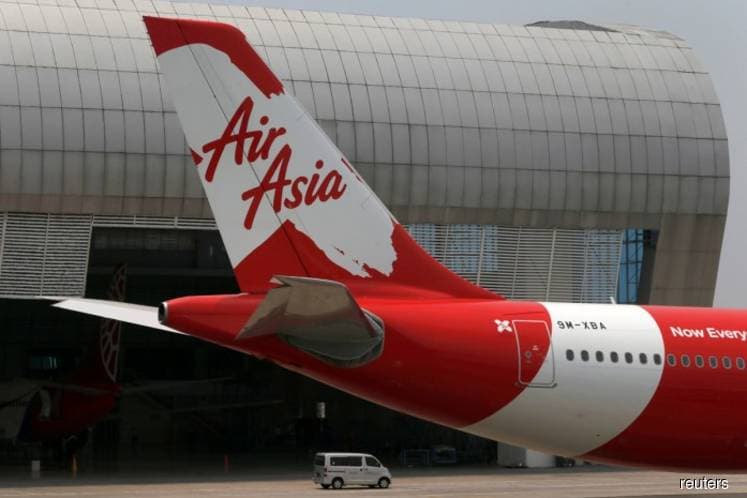
This article first appeared in The Edge Financial Daily on November 23, 2018
AirAsia X Bhd
(Nov 22, 23 sen)
Maintain neutral with a lower target price (TP) of 22 sen: AirAsia X Bhd (AAX) recorded net loss in the cumulative nine months ended Sept 30, 2018 (9MFY18) to the tune of RM213.4 million.
Excluding exceptional items, the normalised net loss of RM238.6 million exceeded our and consensus expectations by a variance of more than 10%. The negative variance was steered by the increase in overall operational expenditure (opex), as a result of the 35.4% year-on-year (y-o-y) rise in fuel expenses in the third quarter ended Sept 30, 2018 (3QFY18) and the provision of doubtful debts.
Following the increase in average fuel price, 9MFY18’s cost of fuel climbed 28.1% higher y-o-y. Cumulatively, the amount accounted for 40.9% of total revenue, which was 8.5 percentage points (ppts) y-o-y higher than in 9MFY17.
Volatile fuel cost remained a major headwind to the long-haul business model, impacting the revenue passenger kilometres (RPK) in 3QFY18 which dropped 3.3% y-o-y. In 3QFY18, we noted that cost per available seat kilometre (CASK) ex-fuel was little changed, only increasing by 0.5% y-o-y, attributable to higher provision of doubtful debts for AAX Indonesia amounting to RM138 million.
Revenue per available seat kilometre (RASK)-to-CASK spread in 3QFY18 stayed in the negative territory as a result of the termination of Tehran and gradual reduction in flights to Kathmandu. Notably, the impact was evident in its operating numbers.
AAX’s available seat kilometres (ASK) dropped 3.6% y-o-y in 3QFY18 which translated into the 3.3% y-o-y decline in RPK. Nonetheless, the 1% y-o-y increase in passengers carried after the general election led to a 1ppt gain in load factors which reached 80% in 3QFY18.
This, however, came at a cost with average fares falling 4.6% y-o-y.
Tracing back to 3QFY15, the quarter experienced a net loss of –RM288.2 million before recording a profit of RM201.6 million in 4QFY15.
The main reason for the recovery was the 12.9% decline in average Brent crude oil price, from US$51.29 per barrel to US$44.59 per barrel. So far in 4QFY18, Brent crude oil price has dropped by approximately 26% to hover around US$60 (RM251.40) per barrel to US$65 per barrel in contrast to the 7.4% rise in 3QFY18.
We believe that jet fuel prices will follow suit and AAX will be able to reap benefits by hedging its jet fuel requirement more moving forward.
While the drop in average fare could weigh down earnings, we believe recovery is on the horizon as core routes start to gain better traction moving forward in addition to the newer ones.
AAX has also exercised prudence by shifting some of the future capacity into other core markets, namely Japan, South Korea and India, to factor in the slower growth from the China segment.
Consequently, we believe further improvement in cost structures such as flights to more cost-effective airports, that is, Avalon Airport, Melbourne, could sustain earnings in the long run.
Given that losses exceeded our estimate, we trimmed down our forecasts to a higher net loss of RM46.9 million in FY18 and a lower net profit of RM105.4 million in FY19.
This is taking into consideration the reduction in its airfares as well as the increase of our operating expenses assumptions in the near term that may outweigh the downtrend in oil price.
We expect full-year earnings to stage a recovery in FY19. This could be possible through further cost-cutting initiatives and better capacity utilisation.
Despite our lower assumptions of the FY18 and FY19 performances, the headwinds faced by AAX is tempered by its prospects, which are tied to its long-term strategic plan of: i) further reduction in CASK following expansion plan; and ii) stronger focus in core markets.
This will be supported by AAX’s gradual shift to modern fleet operation.
However, we are cognisant of the volatility in oil prices given the uncertain outlook as Saudi Arabia plans to reduce global supplies while US President Donald Trump is in favour of increased production.
All things considered, we maintain our “neutral” call with an adjusted TP of 22 sen pegging its earnings per share at a price-earnings ratio of 8.5 times. — MIDF Research, Nov 22